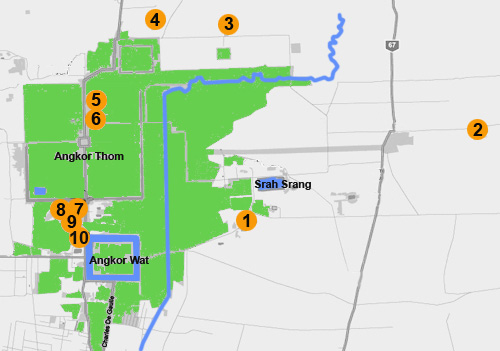Last updated on December 5th, 2018
People come to Siem Reap (and to Cambodia) for Angkor. Those who seek beauty in arts, architecture, old temples and local Cambodian traditions (and the occasional Tomb Raider selfie of course).
Despite the throngs, you don’t need to squeeze between Chinese and Korean tour groups to experience the majesty of Angkor (the Japanese all visited Angkor more than a decade ago it seems). After all, Old Angkor was the size of present day Los Angeles and was home to a million people. Think of the City of Siem Reap as a small district in a large metropolis…
For Cambodians, entrance to the temples is free, and local expatriates usually get into the Angkor Archeological Park after five when the ticket office has closed down. Grilled bananas, green papaya salad, roast meats, fresh fruits and a few cold drinks as the sun sets is part of the local routine. Some people do jog and cycle around the temples when the sun is less harsh, but they must be from Phnom Penh… Days go by and we bask in the magic of Angkor.
Away from the crowds, closer to local villages, these magnificent temples are wonders to behold for those who can take time to discover Angkor at their own pace. Children walk the buffaloes home, men plow their fields while you rest in the shade of dipterocarps.
1. Prasat Kravan
Builder: Hashavarman I
Consecration stele: 921 AD
Cult: Brahmanism (Vishnu)
This prasat is often ignored as it is the last one or first one from Siem Reap, depending on which way the tour buses go. Most guidebooks and guides tend to overlook the five ochre brick towers. Restored in the 1960s, Kravan is the only temple with bas-relief cut into bricks. Pay respect to the superb representations of Vishnu and Laksmi.
2. Banteay Samre
Builders: Suryavarman II & Yasovarman II
Consecration stele:12th century
Cult: Brahmanism (Vishnu)
On your way to the famed Citadel of Women (Banteay Srei), rest your legs at the Citadel of the Samre, an eastern Mon-Khmer aboriginal group that inhabited the Kulen Plateaux. This classic temple was built shortly after Angkor Wat and welcomes pilgrims with a 200 meter long causeway lined Naga balustrade. Admire some of the best preserved Buddhist iconography in Angkor.
3. Krol Ko
Builder: Jayavarman VII
Consecration stele: 12th century
Cult: Bhuddism
The boddhisatva of compassion, Lokesvara, looks down upon the “Cow Enclosure”, in the company of Khrisna who shelters herders and their flocks.
4. Banteay Prei
Builder: Jayavarman VII
Consecration stele: 12th century
Cult: Bhuddism
Located 150 metres north of the smaller Prasat Prei (Temple of the Forest), the Citadel of the Forest follows the architectural style of the Bayon and its overflowing decorations. Half of the four story superstructures are still standing watched over by lone temple guards.
5. Preah Pithu
Consecration stele: 12th century
Cult: Brahmanism and Buddhism
These four Hinduist and a Buddhist temples were not built around the same period. The decorations are incomplete but there are noteworthy carvings of the Churning of the Sea of Milk, Hindu deities, devatas as well as floral motifs.
6. Kleang
Builders: Jayavarman V (North) & Suryavarman I (South)
Consecration stele:11th century
The two kleang (warehouse), given their monumental sizes, meticulous architecture and beautiful ornamentations, are best described as royal warehouses rather than storerooms. The Kleang may have also been used as palaces for visiting high ranking dignitaries and foreign emissaries.
7. Prasat Bei
Consecration stele: 10th century
Cult: Brahmanism (Shiva)
The “Temple of the Three (Towers)” was never completed. The side towers rise just above the level of the doors. A three headed elephant is visible on lintel of the central tower.
8. Prasat Thma Bay Kaek
Consecration stele: 10th century
Cult: Brahmanism
The Temple of the Stone for Rice to Feed the Crows is located by the moat of Angkor Thom. A single square tower made of bricks stands at the centre. To the east, a terrace with laterite benches which used to be covered with sandstone blocks, probably served to feed crows.
9. Baksei Chamkrong
Builders: Harshavarman I – Rajendravarman II
Consecration stele: 10th century
Cult: Brahmanism (Shiva)
The temple’s name literally means “waiting under the bird”. Legend says that a bird protected the King from his enemies under his wings. One of the first temples of brick and laterite used to house a golden statue of Lord Shiva. The pyramid is only thirteen meters high, but the neat trick of proportional reduction (the higher steps are shorter). Avoid climbing as you would likely fall and damage the temple further.
10. Ta Prom Kel
Builders: Jayavarman VII
Consecration stele: 12th century
Cult: Buddhism
A chapel associated with one of the many hospitals built by our greatest King (102 for the city of Angkor alone). “He felt his subjects’ afflictions more than his own; for the suffering of the people is the suffering of the King.”
![]()
If you find our blog useful, please consider making a hotel or flight booking with our affiliate links. Happy travels!

